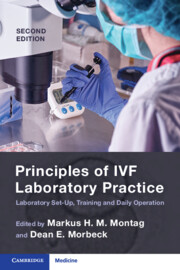Book contents
- Principles of IVF Laboratory Practice
- Principles of IVF Laboratory Practice
- Copyright page
- Contents
- Contributors
- Foreword
- The Evolution of IVF Practice
- Section 1 Starting a New Laboratory and Training Protocols
- Section 2 Pre-procedure Protocols
- Section 3 Gametes
- Section 4 Insemination/ICSI
- Section 5 Fertilization Assessment
- Section 6 Embryo Assessment: Morphology and Beyond
- Section 7 Embryo Cryopreservation
- Section 8 Embryo Transfer
- Section 9 Quality Management
- Chapter 40 Verification of Specimen Identity by Double Checking with a Witness
- Chapter 41 Quality Management in the IVF Laboratory
- Chapter 42 Troubleshooting in the IVF Laboratory
- Chapter 43 Disaster Preparedness in the IVF Laboratory
- Index
- References
Chapter 42 - Troubleshooting in the IVF Laboratory
from Section 9 - Quality Management
Published online by Cambridge University Press: 07 August 2023
- Principles of IVF Laboratory Practice
- Principles of IVF Laboratory Practice
- Copyright page
- Contents
- Contributors
- Foreword
- The Evolution of IVF Practice
- Section 1 Starting a New Laboratory and Training Protocols
- Section 2 Pre-procedure Protocols
- Section 3 Gametes
- Section 4 Insemination/ICSI
- Section 5 Fertilization Assessment
- Section 6 Embryo Assessment: Morphology and Beyond
- Section 7 Embryo Cryopreservation
- Section 8 Embryo Transfer
- Section 9 Quality Management
- Chapter 40 Verification of Specimen Identity by Double Checking with a Witness
- Chapter 41 Quality Management in the IVF Laboratory
- Chapter 42 Troubleshooting in the IVF Laboratory
- Chapter 43 Disaster Preparedness in the IVF Laboratory
- Index
- References
Summary
A fully equipped laboratory with state-of-the-art air control; meticulously calibrated and maintained incubators and microscopes; culture media and medium supplements scrupulously selected after stringent after-market assays; validated, efficient and effective laboratory protocols and techniques; skilled, experienced, knowledgeable embryologists. What could go wrong? Why and how could there ever be a poor outcome, such as failure of fertilization, oocyte degeneration, arrested development of embryos or low blastocyst formation rate, poor survival of embryos after cryopreservation or low embryo implantation rates? Every laboratory and clinic must be prepared to encounter one, some or all of these undesired events and set out on a systematic analysis of the entire process to identify and address ‘the problem’. In this chapter, some suggested strategies and tools for an effective investigation and focussed troubleshooting are presented. These are designed to assist the embryologist, as well as the entire clinical team, to embark on a structured evaluation of each factor that may underlie, cause and/or contribute to a failure or a suboptimal outcome. Indeed, the engagement of the team is encouraged, providing a valuable perspective in a time when one must resist the temptation to ascribe poor performance in in vitro fertilization (IVF) solely to the laboratory.
- Type
- Chapter
- Information
- Principles of IVF Laboratory PracticeLaboratory Set-Up, Training and Daily Operation, pp. 312 - 323Publisher: Cambridge University PressPrint publication year: 2023



